6sense vs RollWorks: A Practical Buyer’s Guide for ABM Teams
If you stacked 6sense and RollWorks side by side, you’d see a lot of overlap—intent data, audience building, and multichannel ads. But once you start actually using them, the differences become clearer.
This article breaks down how 6sense and RollWorks each tackle core ABM functions like targeting, intent, reporting, and sales alignment.
Whether you’re looking for enterprise-grade orchestration or just want to get campaigns out the door fast, we’ll help you figure out which tool fits your GTM motion best.
And while we’re not comparing Influ2 directly, we’ll show you where we fit in—especially when you want to move beyond accounts and engage the actual humans making decisions (which is how you make a real impact on deals).
Let’s dive in.
6sense vs. RollWorks: The TL;DR
Short on time? Here’s the cheat sheet.
| 6sense | RollWorks | |
| Ideal for... | Enterprise teams with mature ABM programs | Small to mid-sized teams getting started with ABM |
| Intent data | Multi-source (Bombora, G2, TrustRadius, TechTarget), AI-analyzed, deeply integrated | Bombora intent included, G2 optional; simpler interface for faster use |
| Web deanonymization | Yes | Yes |
| Advertising capabilities | Display, video, LinkedIn, and other formats; works with dynamic audience segments | Easy-to-launch display and social ads, plus retargeting for deanonymized website visitors; great for fast execution |
| Account targeting | Advanced predictive modeling, fit + intent scoring, dynamic audience segmentation | Simple targeting with firmographic, technographic, and intent filters. Automatically scores prospects based on behavior and engagement levels |
| CRM and MAP integrations | Salesforce, HubSpot, Marketo, Dynamics, Pardot, Eloqua | HubSpot, Salesforce, Eloqua, Marketo |
| Sales-marketing alignment | Deep CRM integrations, real-time intent alerts, sales workflows | Journey stage reports and playbooks |
| Reporting and analytics | Custom dashboards, predictive insights, multi-touch attribution | Easier out-of-the-box reporting, basic but effective dashboards |
Comparing 6sense to RollWorks in 5 main ABM features
Both of these tools are built to support your ABM strategy. But how they do it (and the capabilities of each) are very different.
6sense is best known for its deep, AI-powered account insights. Think of it as a detective for your target list—scouring the web, third-party data feeds (like Bombora and TrustRadius), and your own CRM to find out which accounts are heating up.
If you want one platform that predicts which companies are most likely to buy and lets you launch multichannel ad campaigns from the same dashboard, that's what 6sense promises.
RollWorks, on the other hand, is a “build-and-go” ABM workhorse that makes it easy to spin up dynamic account audiences.
You can connect your CRM quickly, create unlimited segments based on firmographics or intent signals (Bombora, G2, or your own site visits), and get display, social, and search ads live fast. It’s the tool for teams who want precise account targeting without a massive learning curve.
Account identification and targeting
Finding and prioritizing accounts are key activities for your ABM strategy. Here’s how both tools approach this.
6sense focuses on using predictive models and intent data to score accounts by fit and interest. You can start by building out a deep ideal customer profile with their Audience Builder tool, and then sort through accounts that match the criteria you’ve set.
Here’s how it works:
- Build an audience with filters: With 80+ filters, including firmographic, technographic, and behavioral filters, you can define what the right customer looks like.
- Prioritize accounts: Using a combination of intent data, criteria you’ve set, and predictive AI, 6sense surfaces accounts that are more likely to be in-market based on historical behavior.
- Build workflows for your overall ABM strategy: 6sense’s workflow builder allows you to run automated enrichment to keep your records fresh, set up sales plays, or build and run ad campaigns with dynamic segments.
RollWorks takes a more streamlined approach to account targeting. It doesn’t have the predictive power of 6sense, but it’s very easy to build a target account list based on firmographics, CRM data, website activity, and intent data.
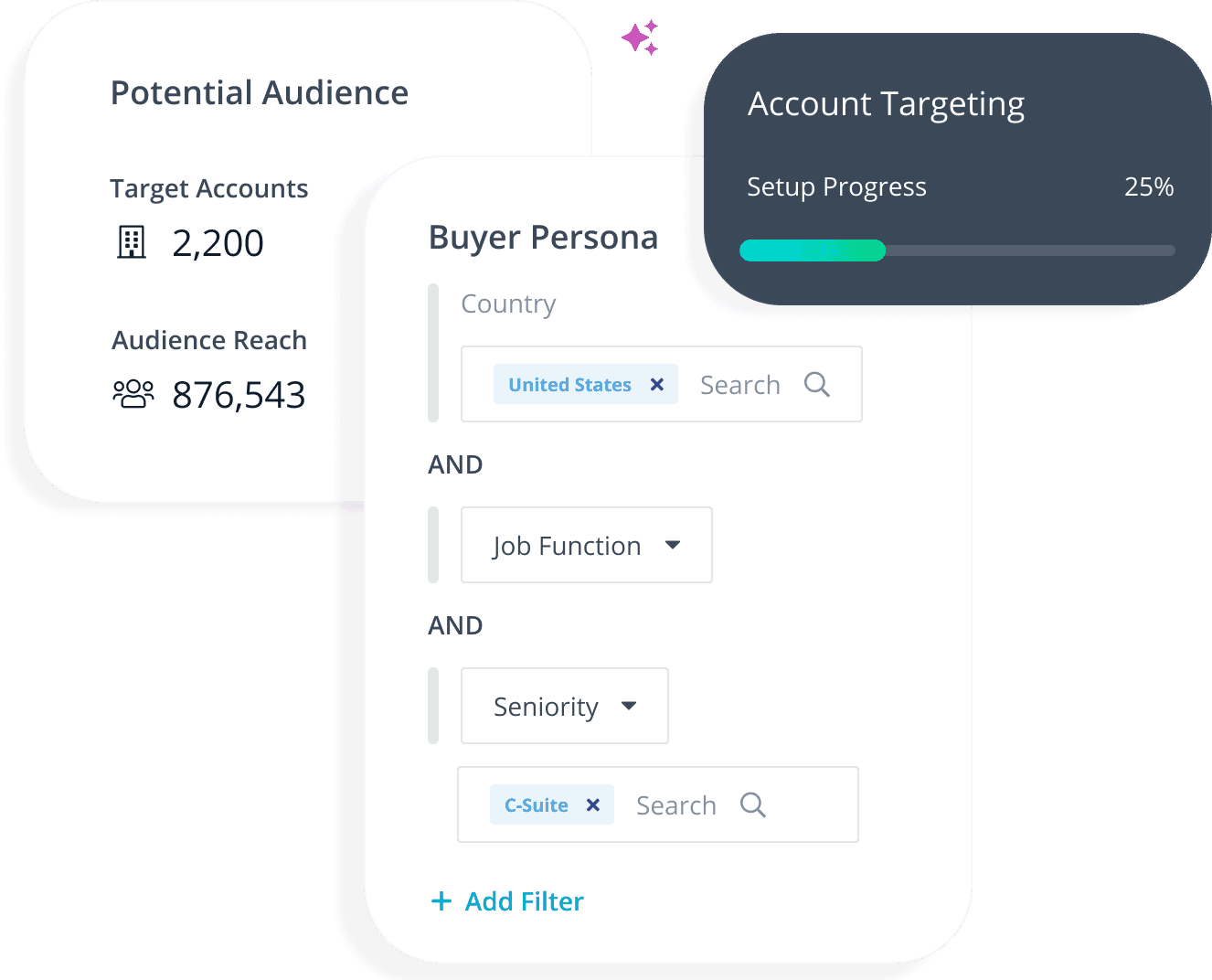
Here’s what this includes:
- Identify anonymous web visitors: See which companies are browsing your website, and match them to your target accounts.
- Create dynamic lists with filters: Use the filters in RollWorks to set who you want to target, then use a combination of first-party data from your CRM, plus firmographic and intent data to build lists. These lists keep updating as new accounts match the criteria you’ve set.
- Set up and monitor journey stages: Create and customize customer journey stages by importing data from your CRM and other tools, and setting specific rules. Then, you can see which accounts are aware of or considering your product, or the deal stage they’re in.
Key takeaways:
- 6sense offers more developed predictive analytics, even allowing you to build your own predictive models within the tool.
- RollWorks is much faster to implement, and it’s easier for mid-sized teams who are earlier in their ABM maturity to build quick lists and develop a strategy from there.
Intent data
Knowing who is searching for your product or which accounts have increased their research into related topics is a great way to narrow down your focus for ABM. Here’s how both 6sense and RollWorks collect and present intent data.
6sense blends first-party and third-party intent data, showing you keyword-level site engagement from around the web. Then, it uses AI to analyze the intent based on all the activities, and give you a list of potentially warm accounts.
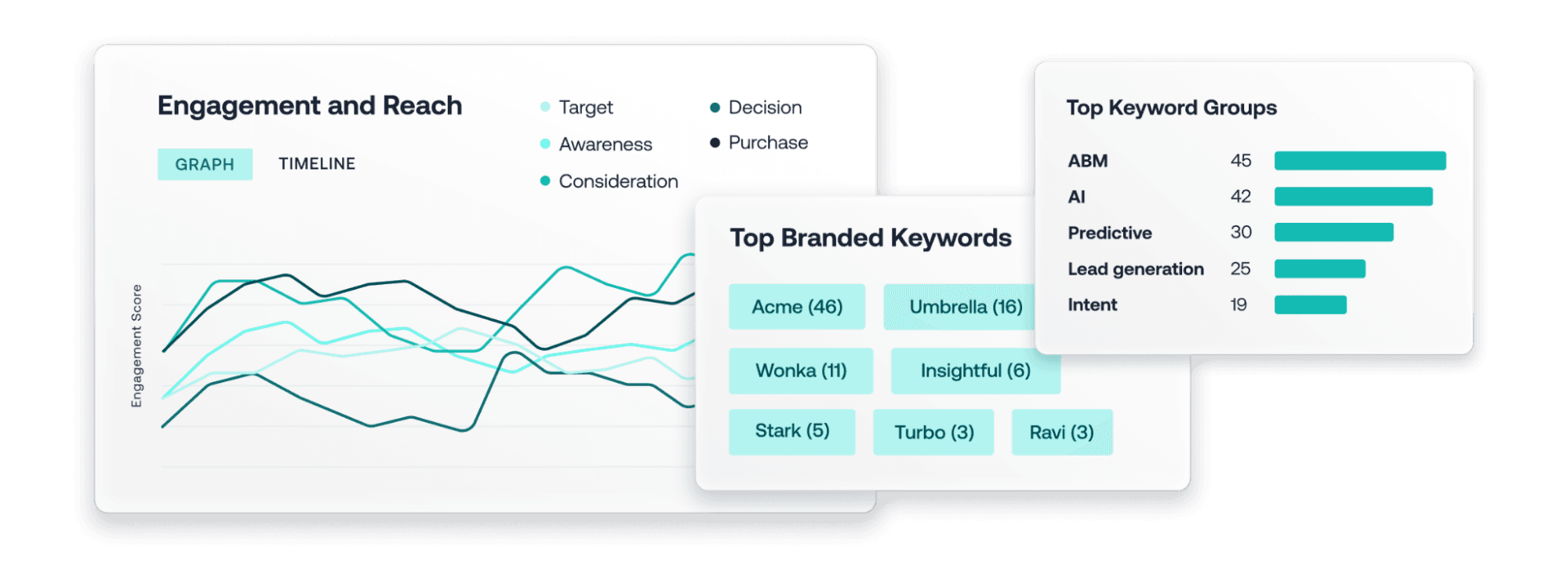
Here’s how it looks in practice:
- Get intent data from multiple sources: 6sense is a hub for intent data, collecting from sources like Bombora, G2, TrustRadius, TechTarget, and first-party data from your website and CRM.
- See where buyers are in their journey: 6sense’s deeply developed predictive model acts as a behavioral intelligence tool, analyzing how target accounts behave online, and identifying patterns that show where they are in their buying journey.
- Turn intent data into automated workflows: You can use intent data as triggers inside 6sense’s workflow builder. For example, when an account hits a certain intent score, they could be added to a segment or sent an automated sales sequence.
RollWorks also integrates intent data, mainly by partnering with Bombora. (You can also get intent data from G2 into RollWorks, but only if you’re paying for an account there.) While the insights aren’t as advanced as 6sense, you’ll see clear information that your team can act on quickly.
Here’s what that means:
- Keyword-based intent signals: See what your target accounts are researching, and when they start to increase their research into your product or category.
- Update your target lists on the fly: Use online engagement triggers to modify your account lists in near real time.
- See the “Fit Score” of active accounts: RollWorks combines buying signals with the criteria you set to show you a list of accounts that are actively searching for a product like yours and fit your ICP.
Key takeaways:
- 6sense provides more layered and predictive intent scoring, which is ideal for sophisticated ABM programs.
- RollWorks keeps things simpler, meaning you can execute faster.
- Both tools rely on Bombora to augment their intent data, but 6sense also includes a wider variety of sources.
Want to take it a level deeper?
If you want to succeed at ABM, account-level data isn’t enough anymore. This is where Influ2’s contact-level advertising makes the difference.
Unlike 6sense or RollWorks, Influ2 lets you serve ads to individual decision-makers, not just accounts.
Influ2 then gives you contact-level behavioral data—like who saw and clicked which ads, and which pages they visited—which you can then hand off to sales for immediate follow-up.
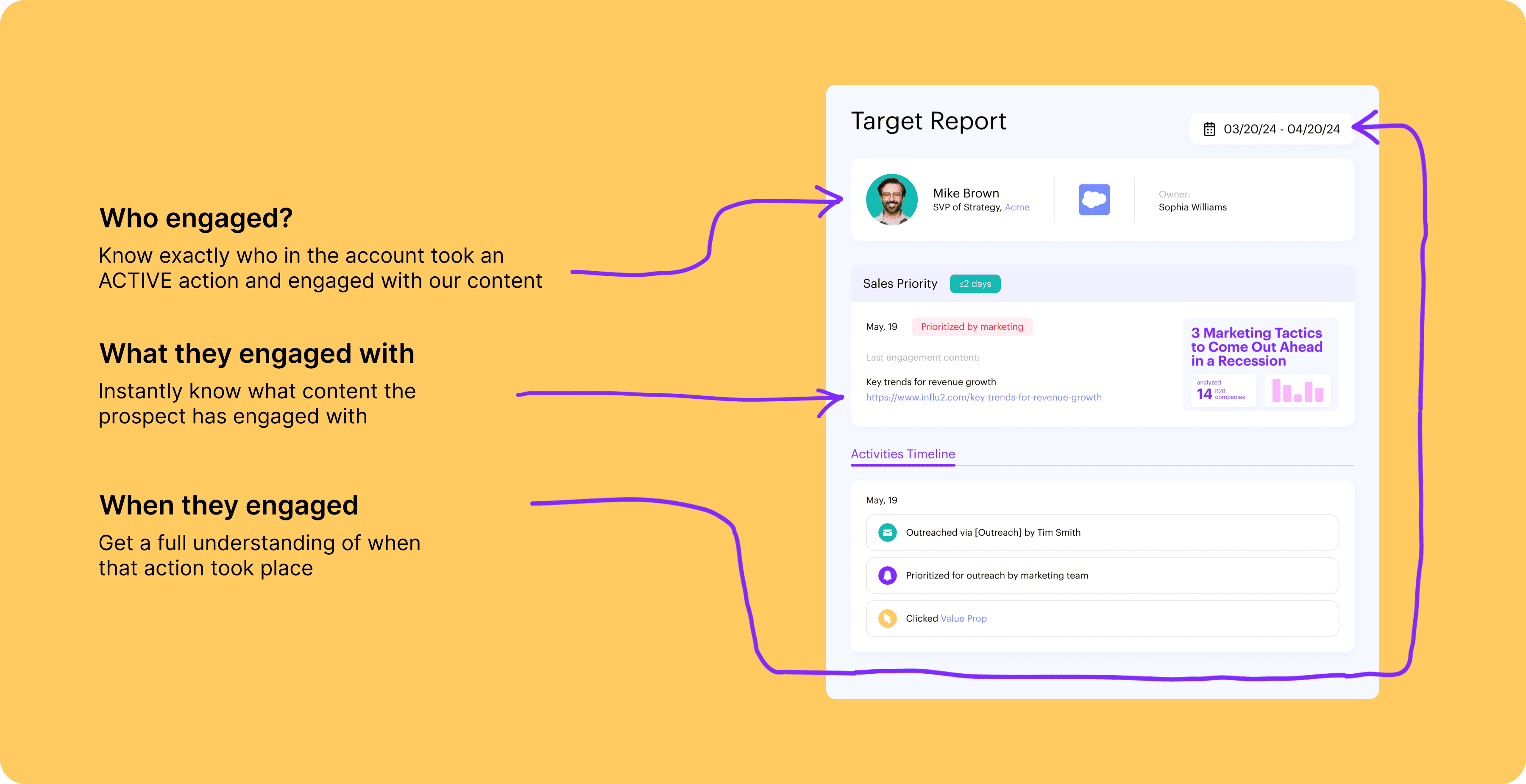
So while 6sense and RollWorks can work at the account level, Influ2 helps close the gap at the contact level.
Advertising and retargeting
A big part of ABM advertising is making sure your target audience actually sees your message—and ideally, at a time when they’re interested in your product. Both 6sense and RollWorks offer big capabilities for advertising, but here’s how they’re different.
6sense’s advertising capabilities are deeply tied to its predictive engine. You can launch display ad campaigns that automatically adjust based on where the tool determines each account is in the buying journey. The ads can be tailored based on both behavioral signals and fit, helping you drive awareness and engagement with in-market accounts.
Here’s what that looks like:
- Campaigns triggered by buying stage: Ads are dynamically delivered based on each account’s stage, for example, early-stage awareness vs. late-stage decision.
- Multi-channel reach: Run campaigns across display, Facebook, LinkedIn, YouTube, and connected TV from inside the platform.
- Make advertising a piece of an overall outreach workflow: With 6sense’s workflow builder, you can automate email outreach, push people to your CRM, or even purchase contact lists alongside your ad campaigns. 6sense even gives you pre-built workflow templates to get started with.
The primary focus of RollWorks is powering advertising for ABM, so they stand tall with a DSP system that’s also easy to use. One user calls RollWorks “ABM simplified”, and adds: “It has a clean design, easy to connect to CRM, list building simplified and quick. It allows you to be nimble and get campaigns set up in one day if necessary.”
Here’s what that includes:
- Multi-channel ad delivery: Run display, LinkedIn, and Facebook ads with guided setup flows.
- Retarget site visitors: RollWorks can identify anonymous visitors on your site and add them to retargeting campaigns with relevant messaging.
- AI-powered bid optimization: The BidIQ tool automatically optimizes what you’re bidding and how much you spend on each creative, funneling more money to the ads that perform better.
As one user puts it: “Rollworks is making our ad spend more efficient by domain targeting. We are assured that our dollars are stretched and not wasted on accounts that are not within our target.”
Key takeaways:
- Both tools have their own built-in DSP, giving you the ability to send targeted ads to specific accounts in your lists.
- 6sense advertising leans heavily on its AI-powered predictive models, meaning targeting, ad spend, and even ad creatives are adjusted automatically based on the criteria you set and the intent signals that 6sense collects. It takes longer to set up, but it’s more efficient in the long run.
- RollWorks is fast-moving and easy to set up and run, giving you the ability to be nimble and respond quickly to changes in the market.
Want to make your advertising more precise?
6sense and RollWorks have the same major gap: they don’t allow you to send targeted ads to individuals in your target accounts.
Both are built on domain targeting, meaning the tools attempt to reach relevant people, but often end up including hundreds (or thousands) of irrelevant contacts, even if your buying committee is only a few people.
That’s what separates Influ2 from tools like 6sense and Rollworks. Precision.
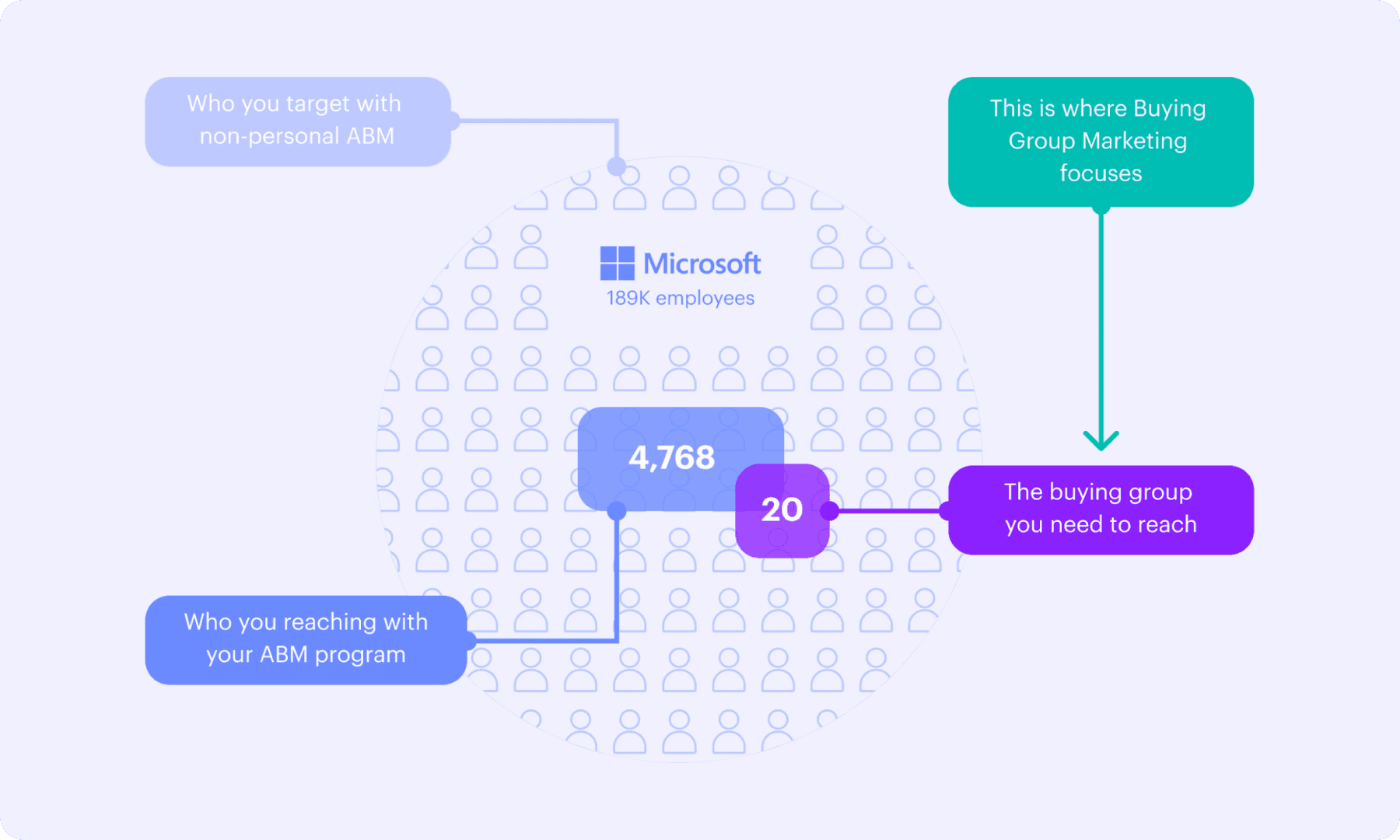
With Influ2, you can:
- Run contact-level ad campaigns to named buyers your sales team is targeting.
- Track individual engagement (who clicked, who didn’t, what page they viewed).
- Use these engagement signals to trigger follow-ups or update lead scores automatically.
While RollWorks and 6sense work for broad account-level ad targeting, that’s simply not enough anymore.
Influ2 goes beyond accounts and allows you to hyper-focus on the people who are actually involved in a purchase decision. Use it to connect your ad strategy directly to the humans behind the account.
Sales and Marketing alignment
One of the biggest promises of ABM is better alignment between sales and marketing, and both 6sense and RollWorks have features that promise to help.
6sense is known for its deep integrations with CRM platforms. The goal is to help Sales and Marketing work from the same playbook, using the same signals, so sellers always know when to reach out and why.
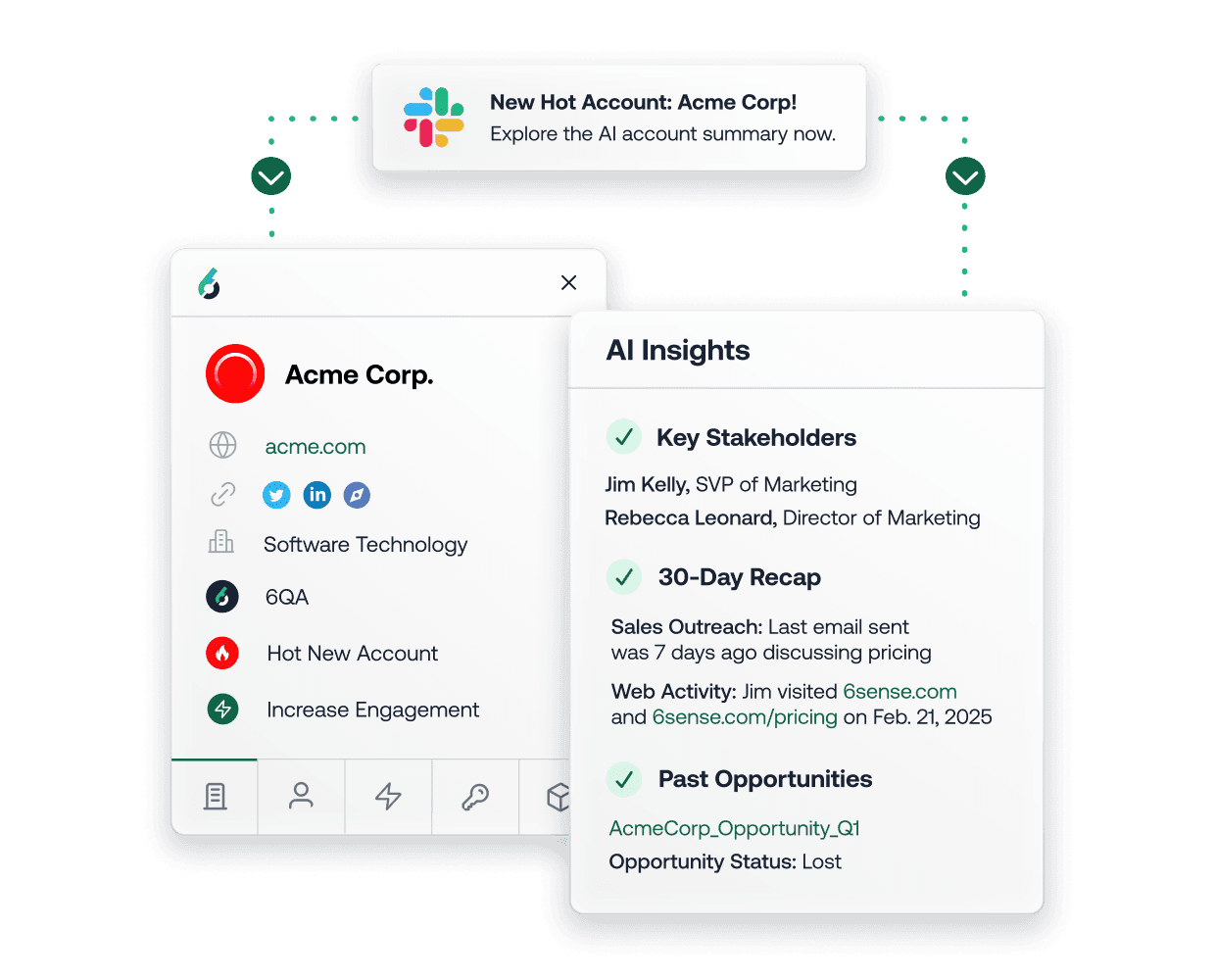
Here’s how 6sense helps align teams:
- Sales intelligence surfaced in nearly real-time: 6sense pushes account activity, intent signals, and buying stage information directly into CRM and sales engagement tools like Outreach or Salesloft.
- Orchestrated, automated sales plays: With workflows, you can trigger sales plays based on account behavior, like when a prospect account surges in intent or visits a pricing page.
- AI-powered insights and suggestions: 6sense’s Sales Copilot surfaces recommendations to sales teams about who to contact, which messaging resonates best, and the best moment to engage. It can even automate personalized email outreach, and give your sales team a quick summary of each lead and their history of interactions with your company.
Here's one user's take.
That said, not everyone agrees on this. In many cases, sales teams find the insights from 6sense aren’t actionable.
While they’re working accounts and reaching out to contacts on the sales side, many teams still feel disconnected from what marketing is doing, and some end up ignoring the notifications from 6sense because they can’t tie it directly to their work.
RollWorks approaches sales and marketing alignment in a simpler way. It doesn’t have as many predictive elements as 6sense, but it gives sales teams visibility into account activity and campaign impact.
Here’s how it helps:
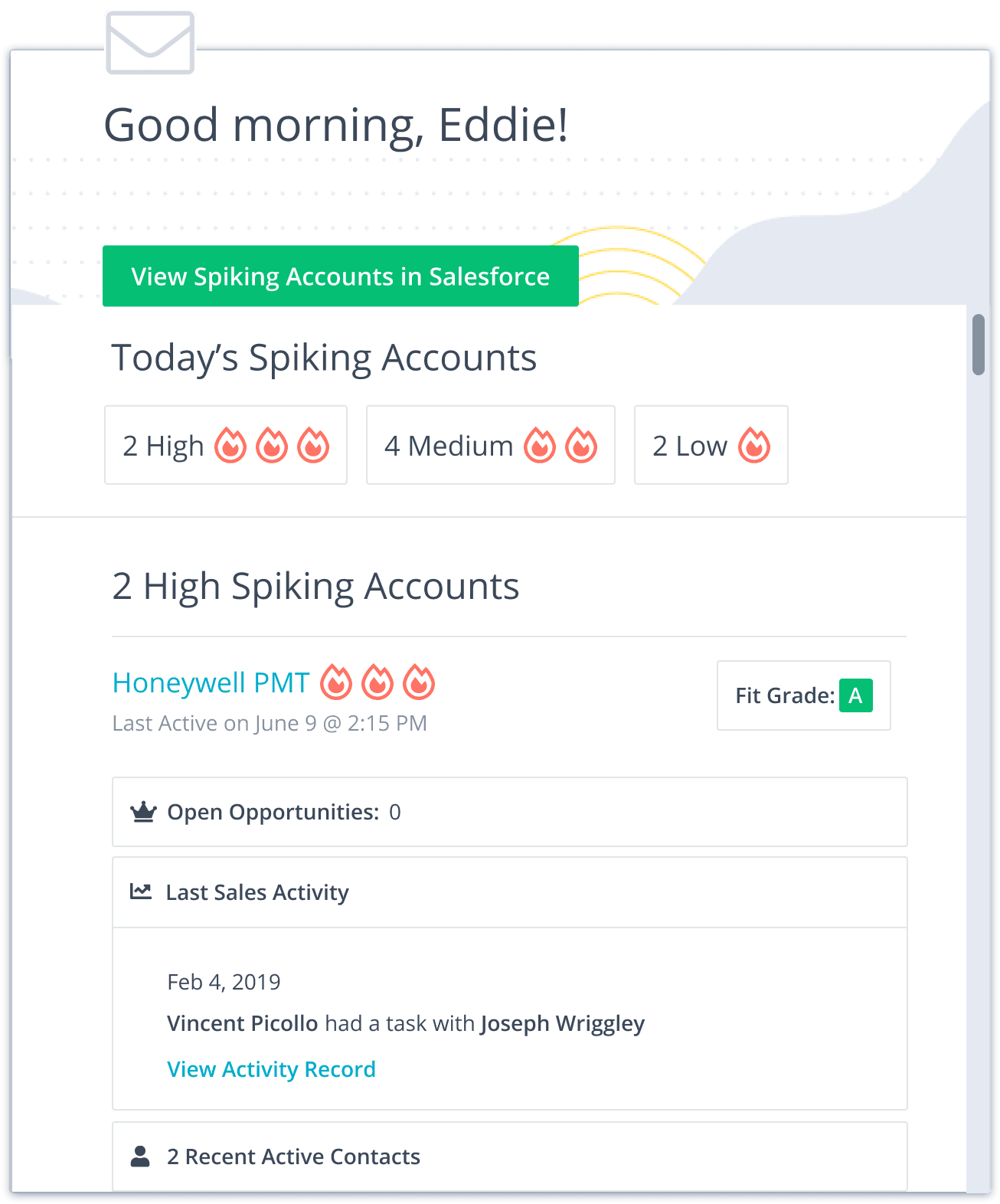
- Sales Insights dashboard: Reps get a view of which accounts are engaging with ads, emails, and your site right inside Salesforce or HubSpot.
- Journey stage tracking: Sales can see where accounts are in the funnel and adjust their outreach timing accordingly.
- Regular alerts on spiking accounts: Sales teams can get regular alerts on which accounts are showing more interest, giving them clear priorities on who to contact.
Key takeaways:
- Both tools help create a more coordinated GTM strategy, but 6sense offers more automated and guided sales actions.
- While users love RollWorks’ integration with HubSpot and Salesforce, those are the only CRMs it connects to. So if your team uses another CRM, it may not make sense to use RollWorks.
- RollWorks is simpler but very accessible, and its Salesforce dashboards are easy for Sales to adopt quickly.
Get more visibility into your alignment with Influ2
Both 6sense and Rollworks tout integrations with sales tools and timely notifications as “alignment tools” to help Marketing and Sales work together smoothly.
In reality, this is often simply not enough to align teams on common goals and targets. In fact, our recent study found that 53% of companies face a broken hand-off, where sales follows up with less than 35% of marketing-engaged prospects.
That’s where Influ2 takes a step forward.
Since the tool is built on the basis of close teamwork between Marketing and Sales, it includes features that can actually help you align, including the Sales and Marketing Alignment Dashboard.
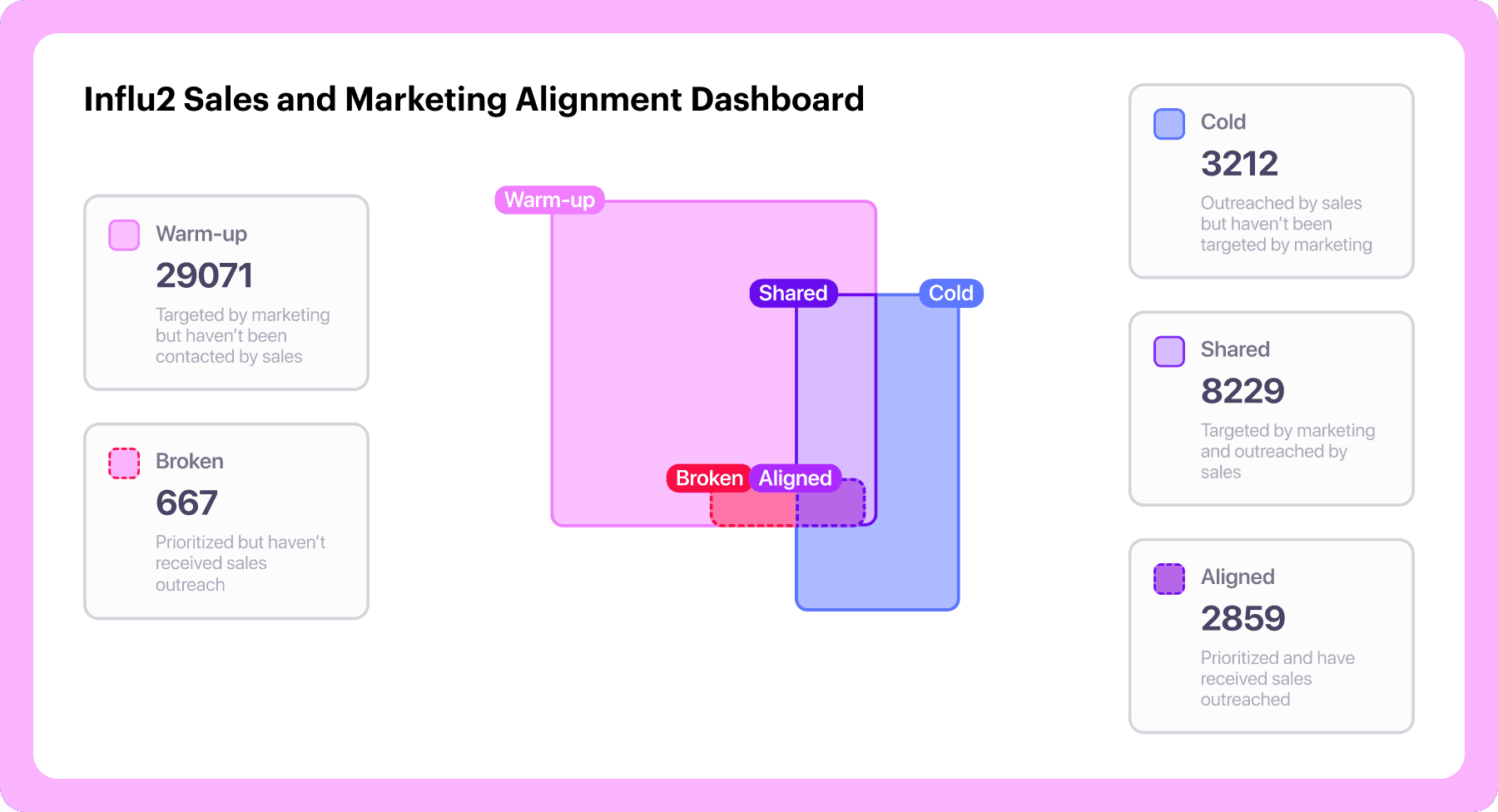
With this dashboard, you can see:
- Which contacts have been warmed up by marketing
- Which contacts are being targeted by sales
- Where there’s overlap (and where there are opportunities to improve)
From here, you can get specific contact lists to see who is getting cold outreach from Sales (but hasn’t been engaged by marketing), or contacts who have been engaged by Marketing and are showing interest, but haven’t been contacted by Sales.
Influ2 helps your teams step out of their silos and work together, without stepping on each other’s toes.
Reporting and analytics
You can’t improve what you don’t measure—and in ABM, having the right analytics makes it easier to prove ROI and refine your campaigns. Both 6sense and RollWorks offer reporting features, but they differ in depth and focus.
6sense delivers highly detailed, customizable reporting across the full buyer journey. It’s especially strong for teams who want to dig into pipeline influence, conversion rates, and multichannel performance across the funnel.
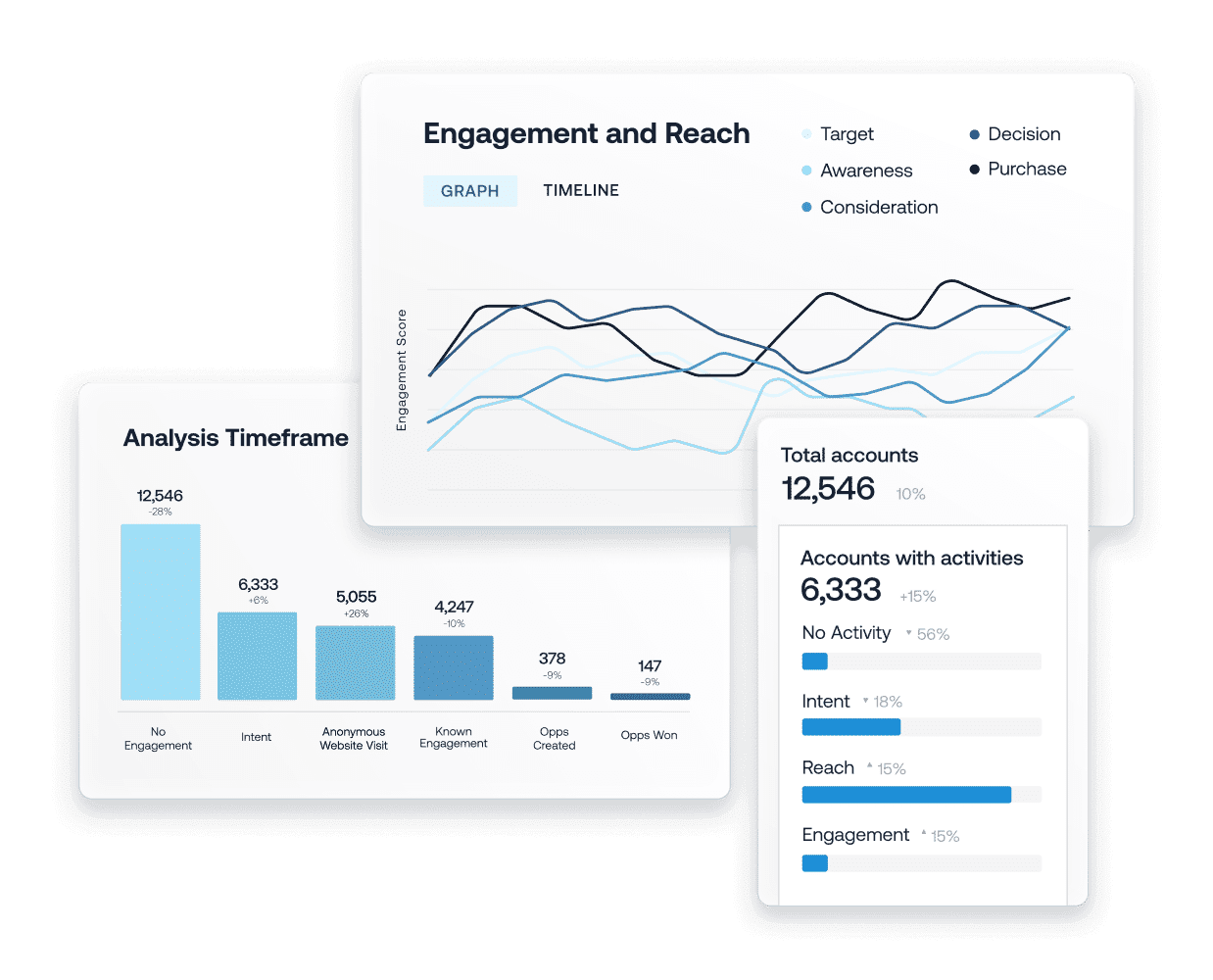
Here’s what you get:
- Full-funnel attribution: Track how your efforts impact pipeline and revenue, from anonymous browsing to closed-won deals.
- Journey insights dashboards: See how accounts move through buying stages over time, and where they’re getting stuck.
- Custom reporting with robust filters: Build and share reports that highlight performance by persona, segment, industry, or any combination of filters.
RollWorks also gives you visibility into how accounts are progressing and engaging, but with a more out-of-the-box, streamlined approach. The reporting is clean and accessible, especially for smaller teams that want insights without a steep learning curve.
Here’s what it looks like:
- Cross-channel ad engagement dashboards: Easily see data from multiple ad campaigns in one simple dashboard, showing your ad spend, accounts reached, page views, and more. You can also see a revenue impact dashboard, ad performance reports, and granular conversions.
- Journey stage reports: Customize the journey stages of your audience, and you’ll be able to see a specific report on how your audience is moving through each stage, including accounts that progressed or regressed during a certain time period.
- Deep journey reporting for each account: With data from your CRM and marketing systems imported into RollWorks, you can see specific actions taken by each account, and how that influenced their position in the buying journey.
Key takeaways:
- While both tools give you insights into the customer journey and your campaign results, some users do mention that Rollworks’ campaign reporting is less in-depth than other tools.
- 6sense offers more customization in its reporting and lets you go deeper into behavioral analysis and attribution.
- Rollworks offers cleaner, simpler dashboards that are easier to set up and use, but are less flexible.
Want to see how ad campaigns influence pipeline and revenue?
With most ABM tools, Marketing is doing the hard work of influencing deals, and getting none of the credit.
Since traditional tools like 6sense and Rollworks only credit Marketing when someone fills out a form, all those ad campaigns that convince someone to listen when a salesperson reaches out aren’t counted as being influenced by Marketing.
With Influ2, we turn traditional attribution on its head.
Our reporting is based on influence at every stage of the pipeline, not just form fills. So when someone clicks on an ad from your Influ2 campaign, doesn’t fill out a form, and is later contacted by Sales, Influ2 can still track the influence your campaign had on the deal.
With Influ2’s Revenue report, you’ll see how your ad campaigns influenced meetings, pipeline generation, and won deals (including direct influence on revenue).
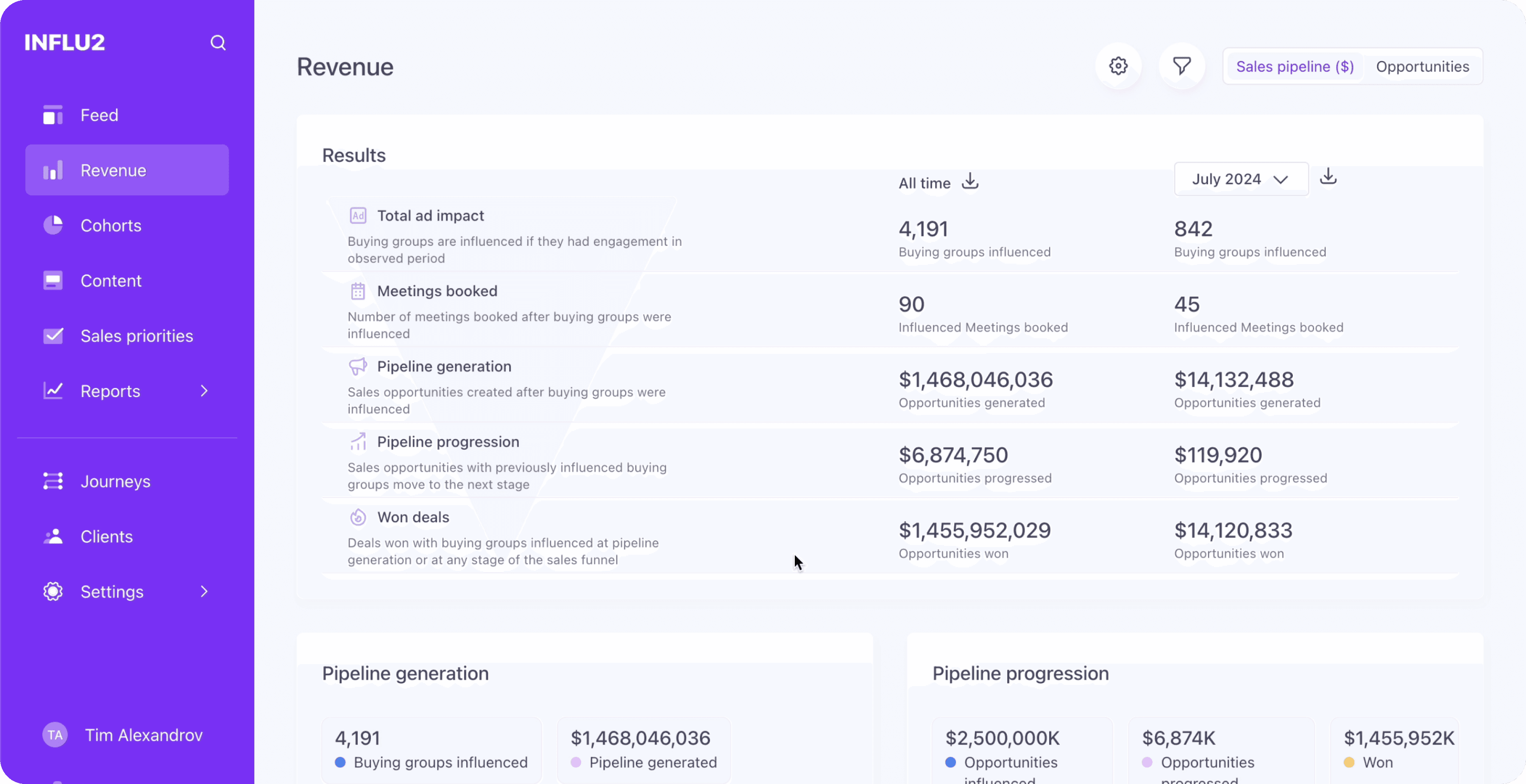
This allows you to deeply analyze your overall GTM efforts, and justify the spend on big ABM campaigns.
Choosing between 6sense and RollWorks: 4 factors to consider
We’ve been comparing two tools with a lot of overlap, so let’s make this simple. Here are four questions you can ask yourself to see whether 6sense or RollWorks is a better option for you.
1. How fast do I need to get started?
If your team needs to get campaigns off the ground quickly, RollWorks might be the better pick. Users say it has an intuitive setup, out-of-the-box integrations, and straightforward workflows. Some customers reported that the setup took a week, or even just a few days.
6sense has more features, but requires more setup time to unlock its full potential, especially if you’re building custom predictive models or deep intent workflows. Users reported a setup time of at least three months, which means it’s better for teams that can dedicate the time upfront for long-term gains.
2. How deeply do I need to customize my reporting?
If your team needs to build more granular, multi-touch attribution models or custom journey dashboards, 6sense has an advantage over RollWorks. It’s built for deep analytics and pipeline-level visibility.
RollWorks gives you clean dashboards, but with less customization. For many mid-sized teams, that’s actually a plus—it gives them clear data without overwhelming them. But when you want more granular insights, you’ll find yourself doing a lot of manual data stitching.
3. Do I need strong predictive analytics and AI-driven tools?
If you’re planning to use AI to identify in-market accounts and route them dynamically to sales or campaigns, then 6sense is a good option.
Its predictive modeling engine analyzes intent signals across multiple data sources to forecast purchase behavior.
RollWorks is lighter on the AI side. It surfaces buying signals and gives you fit scores, but it’s better for teams who want more manual control over how they prioritize accounts.
4. Do I have the resources for a complex ABM program, or do I need something simpler?
6sense caters to enterprise companies with more mature ABM programs. When you have a dedicated role managing the platform and interpreting insights, you’ll get powerful results. But when you don’t have the bandwidth to maintain the models, campaigns, and integrations, it can get real overwhelming, real fast.
RollWorks is ideal for leaner teams or companies just starting with ABM. It’s flexible and easy to manage without requiring a ton of support.
Take your ABM strategy to the contact level with a tool you may not have considered
While 6sense and RollWorks help you find and prioritize the right accounts, they don’t give you much visibility into the individuals who are engaging. In fact, they can’t even tell you who your ads reach. That’s where Influ2 steps up to bat.
Influ2 brings your ABM strategy down to the contact-level by delivering ads directly to named buyers in your target accounts. You can then see which decision-makers saw and clicked your ads.
Here’s how Influ2 works alongside (or replaces) ABM tools like 6sense and RollWorks:
- Contact-level ad targeting: Serve display and social ads to specific contacts, not just accounts.
- Individual engagement tracking: Get behavioral insights like who clicked on your ad, how often, and which landing pages or resources they explored.
- Sales-ready signals: Use contact-level engagement to trigger outreach, add to workflows, or prioritize warm leads for sales follow-up.
- Ad campaigns directly aligned with sales priorities: Plug Influ2 into your CRM, and you can pull criteria from there—like sales activity, pipeline stages, or anything else your team tracks —to build audiences that overlap directly with your sales team’s efforts.
Influ2 doesn’t just show you intent—it lets you create intent by targeting named buyers and showing you who’s engaged. And that can make all the difference when it’s time to turn engagement into revenue.
Key takeaways: When to choose 6sense or RollWorks, and why you might need Influ2 instead
If you’re deciding between 6sense and RollWorks, here’s the bottom line:
- Choose 6sense if you need deep predictive insights, advanced segmentation, and a powerful engine to drive a mature ABM strategy. It’s built for enterprise teams that want a full-funnel view and can invest the time (and budget) to get it humming.
- Go with RollWorks if you’re just getting started or need to move quickly. It’s user-friendly, integrates well with existing tools, and helps you launch effective ABM campaigns without a steep learning curve.
But if you want to connect the dots between account-level engagement and individual decision-maker activity, that’s where Influ2 comes in.
Whether or not you choose to invest in an overall ABM platform, Influ2 is the only tool that helps you take action at the contact level, bridging the gap between account awareness and real buying behavior.
Use Influ2 to:
- Serve ads to specific people, not just anonymous accounts.
- Track individual engagement like clicks, visits, and ad views.
- Trigger sales outreach based on contact-level ad engagement.
- See how your ad campaigns directly impacted pipeline generation and revenue.
If you’re ready to go beyond “which account clicked?” and start asking “how did our campaigns influence deals?”, Influ2 might be the missing piece of your ABM stack. Book a demo to see how it works in action.
Dominique Jackson is a Content Marketer Manager at Influ2. Over the past 10 years, he has worked with startups and enterprise B2B SaaS companies to boost pipeline and revenue through strategic content initiatives.



